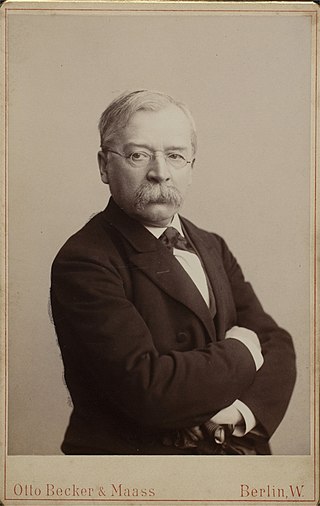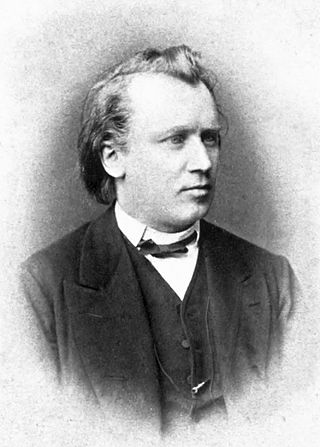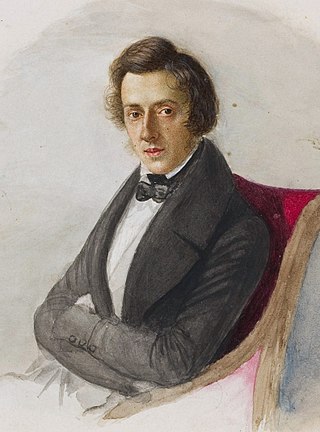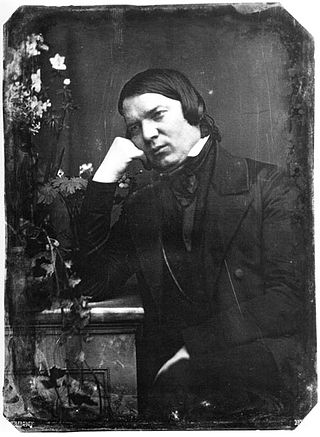Related Research Articles
In musical terminology, tempo also known as beats per minute, is the speed or pace of a given composition. In classical music, tempo is typically indicated with an instruction at the start of a piece and is usually measured in beats per minute (BPM). In modern classical compositions, a "metronome mark" in beats per minute may supplement or replace the normal tempo marking, while in modern genres like electronic dance music, tempo will typically simply be stated in BPM.

The Piano Concerto in A minor, Op. 54, by the German Romantic composer Robert Schumann was completed in 1845 and is the composer's only piano concerto. The complete work was premiered in Dresden on 4 December 1845. It is one of the most widely performed and recorded piano concertos from the Romantic period.

The Piano Quintet in E-flat major, Op. 44, by Robert Schumann was composed in 1842 and received its first public performance the following year. Noted for its "extroverted, exuberant" character, Schumann's piano quintet is considered one of his finest compositions and a major work of nineteenth-century chamber music. Composed for piano and string quartet, the work revolutionized the instrumentation and musical character of the piano quintet and established it as a quintessentially Romantic genre.

Carnaval, Op. 9, is a work by Robert Schumann for piano solo, written in 1834–1835 and subtitled Scènes mignonnes sur quatre notes. It consists of 21 short pieces representing masked revelers at Carnival, a festival before Lent. Schumann gives musical expression to himself, his friends and colleagues, and characters from improvised Italian comedy. He dedicated the work to the violinist Karol Lipiński.

Woldemar Bargiel was a German composer and conductor of the Romantic period.
The Piano Trio No. 3 in G minor by Robert Schumann was written in 1851, and is his opus 110. It has four movements:
- Bewegt, doch nicht zu rasch in G minor, in 6
8 time. In sonata form. - Ziemlich langsam in E-flat major, in 12
8 time and tempo 116 eighth notes to the minute. - Rasch in C minor, in 2
4 time and 138 quarter notes to the minute. A scherzo with two trios, with a tempo marking of Etwas zurückhaltend bis zm langsameren Tempo leading into the first trio, in C major with an upward chromatic theme, and a second trio in A-flat major which is more markedly rhythmic and diatonic in character. - Kräftig, mit Humor in G major, in common time and 104 quarter notes to the minute. There is a prominent episode in this rondo which quotes the C major trio from the scherzo.
The Nachtstücke or Night Pieces are a set of four character pieces for piano by the German composer and pianist Robert Schumann.

Davidsbündlertänze, Op. 6, is a group of eighteen pieces for piano composed in 1837 by Robert Schumann, who named them after his music society Davidsbündler. The low opus number is misleading: the work was written after Carnaval, Op. 9, and the Symphonic Studies, Op. 13.
Andante spianato et grande polonaise brillante in E-flat major, Op. 22, was composed by Frédéric Chopin between 1830 and 1834. The Grande polonaise brillante in E-flat, set for piano and orchestra, was written first, in 1830–31. In 1834, Chopin wrote an Andante spianato in G, for piano solo, which he added to the start of the piece, and joined the two parts with a fanfare-like sequence. The combined work was published in 1836, and was dedicated to Madame d'Este.

The Piano Quartet No. 3 in C minor, Op. 60, completed by Johannes Brahms in 1875, is scored for piano, violin, viola and cello. It is sometimes called the Werther Quartet after Goethe's The Sorrows of Young Werther. The premiere took place in Vienna on November 18, 1875, to an anxious public. Richard Wagner and his wife Cosima were in attendance.

Mazurkas, Op. 17 is a set of four mazurkas for solo piano by Frédéric Chopin, composed in 1832–1833 and published in 1834. The set was dedicated to Lina Freppa.

The Novelletten, Op. 21, is a set of eight pieces for solo piano, written by Robert Schumann in 1838. This composition is dedicated to Adolf von Henselt.

The Piano Quartet in E♭ major, Op. 47, was composed by Robert Schumann in 1842 for piano, violin, viola and cello. Written during a productive period in which he produced several large-scale chamber music works, it has been described as the "creative double" of his Piano Quintet, finished weeks earlier. Though dedicated to the Russian cellist Mathieu Wielhorsky, it was written with Schumann's wife Clara in mind, who would be the pianist at the premiere on 8 December 1844 in Leipzig.
Composed in 1846, the Piano Trio in G minor, opus 17 by Clara Schumann is considered her greatest, most mature four-movement work. It is her only piano trio, composed while she lived in Dresden, following extensive studies in fugue writing and the publication of her Three Preludes and Fugues For Piano, opus 16 in 1845. The trio was premiered by the composer in Vienna on January 15th, 1847.
4 Pièces caractéristiques by Clara Schumann was composed between 1834 and 1836, and published in 1836. The entire work is labeled as opus 5, and is written for solo piano. The pieces are as follows.

The Three Romances for Oboe and Piano, Op. 94 is a composition by Robert Schumann, his only composition for oboe. It was composed in December 1849. The work consists of three short pieces in A-B-A form, and it was written during what was speculated to be one of Schumann's manic episodes.

The Oboe Concerto in E-flat major is an oboe concerto by Vincenzo Bellini, most likely composed in 1823. Bellini's only surviving concerto, the piece is also an important part of his limited instrumental output. Performances typically last between seven and eight minutes.
Märchenerzählungen, Op. 132, is a trio composition by Robert Schumann in four movements for clarinet, viola and piano. He composed the clarinet-viola-piano trio in B-flat major, between 9 and 11 October 1853. The movements are connected by a motif (Kernmotiv). The work is dedicated to Schumann's pupil Albert Dietrich, and was published in 1854 by Breitkopf & Härtel.
The Sei pezzi per pianoforte, P 044, is a set of six solo piano pieces written by the Italian composer Ottorino Respighi between 1903 and 1905. These predominantly salonesque pieces are eclectic, drawing influence from different musical styles and composers. The pieces have various musical forms and were composed separately and later published together between 1905 and 1907 in a set under the same title for editorial reasons; Respighi had not conceived them as a suite, and therefore did not intend to have uniformity among the pieces. The set, under Bongiovanni, became his first published work. Five of the six pieces are derived from earlier works by Respighi, and only one of them, the "Canone", has an extant manuscript.

Three Fantasiestücke for piano, Op. 111, were written in 1851 by Robert Schumann.
References
- ↑ Hinson, Maurice (ed.) (1988). At the Piano with Robert and Clara Schumann, p. 4. Alfred Music Publishing
- ↑ Reich, Nancy B. (2001). Clara Schumann: The Artist and the Woman, pp. 220; 291. Cornell University Press